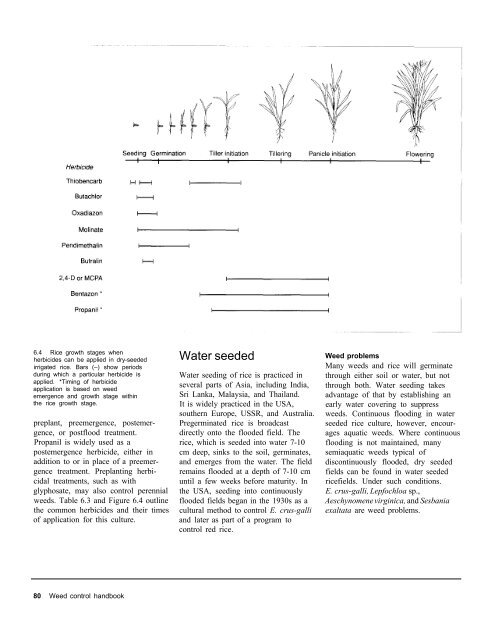A handbbok on Weed Control in Rice.pdf
A handbbok on Weed Control in Rice.pdf
A handbbok on Weed Control in Rice.pdf
You also want an ePaper? Increase the reach of your titles
YUMPU automatically turns print PDFs into web optimized ePapers that Google loves.
6.4 <strong>Rice</strong> growth stages when<br />
herbicides can be applied <strong>in</strong> dry-seeded<br />
irrigated rice. Bars (–) show periods<br />
dur<strong>in</strong>g which a particular herbicide is<br />
applied. *Tim<strong>in</strong>g of herbicide<br />
applicati<strong>on</strong> is based <strong>on</strong> weed<br />
emergence and growth stage with<strong>in</strong><br />
the rice growth stage.<br />
preplant, preemergence, postemer-<br />
gence, or postflood treatment.<br />
Propanil is widely used as a<br />
postemergence herbicide, either <strong>in</strong><br />
additi<strong>on</strong> to or <strong>in</strong> place of a preemer-<br />
gence treatment. Preplant<strong>in</strong>g herbi-<br />
cidal treatments, such as with<br />
glyphosate, may also c<strong>on</strong>trol perennial<br />
weeds. Table 6.3 and Figure 6.4 outl<strong>in</strong>e<br />
the comm<strong>on</strong> herbicides and their times<br />
of applicati<strong>on</strong> for this culture.<br />
80 <strong>Weed</strong> c<strong>on</strong>trol handbook<br />
Water seeded<br />
Water seed<strong>in</strong>g of rice is practiced <strong>in</strong><br />
several parts of Asia, <strong>in</strong>clud<strong>in</strong>g India,<br />
Sri Lanka, Malaysia, and Thailand.<br />
It is widely practiced <strong>in</strong> the USA,<br />
southern Europe, USSR, and Australia.<br />
Pregerm<strong>in</strong>ated rice is broadcast<br />
directly <strong>on</strong>to the flooded field. The<br />
rice, which is seeded <strong>in</strong>to water 7-10<br />
cm deep, s<strong>in</strong>ks to the soil, germ<strong>in</strong>ates,<br />
and emerges from the water. The field<br />
rema<strong>in</strong>s flooded at a depth of 7-10 cm<br />
until a few weeks before maturity. In<br />
the USA, seed<strong>in</strong>g <strong>in</strong>to c<strong>on</strong>t<strong>in</strong>uously<br />
flooded fields began <strong>in</strong> the 1930s as a<br />
cultural method to c<strong>on</strong>trol E. crus-galli<br />
and later as part of a program to<br />
c<strong>on</strong>trol red rice.<br />
<strong>Weed</strong> problems<br />
Many weeds and rice will germ<strong>in</strong>ate<br />
through either soil or water, but not<br />
through both. Water seed<strong>in</strong>g takes<br />
advantage of that by establish<strong>in</strong>g an<br />
early water cover<strong>in</strong>g to suppress<br />
weeds. C<strong>on</strong>t<strong>in</strong>uous flood<strong>in</strong>g <strong>in</strong> water<br />
seeded rice culture, however, encour-<br />
ages aquatic weeds. Where c<strong>on</strong>t<strong>in</strong>uous<br />
flood<strong>in</strong>g is not ma<strong>in</strong>ta<strong>in</strong>ed, many<br />
semiaquatic weeds typical of<br />
disc<strong>on</strong>t<strong>in</strong>uously flooded, dry seeded<br />
fields can be found <strong>in</strong> water seeded<br />
ricefields. Under such c<strong>on</strong>diti<strong>on</strong>s.<br />
E. crus-galli, Lepfochloa sp.,<br />
Aeschynomene virg<strong>in</strong>ica, and Sesbania<br />
exaltata are weed problems.











